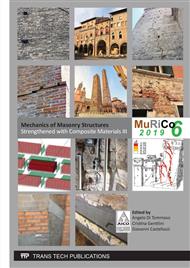[1]
A. Formisano, I. Iaquinandi, F. M. Mazzolani, Seismic retrofitting by FRP of a school building damaged by Emilia-Romagna earthquake, Key Engineering Materials 624 (2015) 106-113.
DOI: 10.4028/www.scientific.net/kem.624.106
Google Scholar
[2]
M. Mosoarca, I. Apostol, A. Keller, A. Formisano, Consolidation methods of Romanian historical building with composite materials, Key Engineering Materials 747 KEM (2017) 406-413.
DOI: 10.4028/www.scientific.net/kem.747.406
Google Scholar
[3]
D. Oliveira, I Basilio, PB Lourenço, Experimental bond behavior of FRP sheets glued on brick masonry, ASCE J. Compos Cons 15(2011) 32–41.
DOI: 10.1061/(asce)cc.1943-5614.0000147
Google Scholar
[4]
E. Grande, M. Imbimbo, E.Sacco, Bond behavior of historical clay bricks strengthened with steel reinforced polymers (SRP), Materials, 4(2010) 585–600.
DOI: 10.3390/ma4030585
Google Scholar
[5]
E. Grande, M. Imbimbo, E. Sacco, Bond behaviour of CFRP laminates glued on clay bricks: Experimental and numerical study, Composites Part B: Engineering, 42(2011), 330–340.
DOI: 10.1016/j.compositesb.2010.09.020
Google Scholar
[6]
E. Grande, G. Milani, Modeling of FRP-strengthened curved masonry specimens and proposal of a simple design formula, Composite Structures, 158(2016) 281-290.
DOI: 10.1016/j.compstruct.2016.09.017
Google Scholar
[7]
M.R. Valluzzi, et al., Round Robin Test for composite-to-brick shear bond characterization, Materials and Structures/Materiaux et Constructions, 45(2012) 1761-1791.
Google Scholar
[8]
E. Grande, M. Imbimbo, The role of the adhesive on the bond behavior of SRPs applied on masonry supports: Experimental and numerical study, Key Engineering Materials, 624(2015) 652-659.
DOI: 10.4028/www.scientific.net/kem.624.652
Google Scholar
[9]
E. Grande, M. Imbimbo, A simple 1D-Finite Element approach for the study of the bond behavior of masonry elements strengthened by FRP, Composites Part B, 91(2016) 548-558.
DOI: 10.1016/j.compositesb.2016.02.005
Google Scholar
[10]
E. Grande, M. Imbimbo, E. Sacco, Numerical investigation on the bond behavior of FRCM strengthening systems, Compos Part B Eng, 145(2018).
DOI: 10.1016/j.compositesb.2018.03.010
Google Scholar
[11]
E. Grande, M. Imbimbo, E. Sacco, Local bond behavior of FRCM strengthening systems: Some considerations about modeling and response, 747(2017).
DOI: 10.4028/www.scientific.net/kem.747.101
Google Scholar
[12]
E. Grande, G. Milani, Interface modeling approach for the study of the bond behavior of FRCM strengthening systems, Composites Part B: Engineering, 141(2018) 221-233.
DOI: 10.1016/j.compositesb.2017.12.052
Google Scholar
[13]
E. Grande, M. Fagone, T. Rotunno, E. Bertolesi, G. Milani, Coupled interface-based modelling approach for the numerical analysis of curved masonry specimens strengthened by CFRP, Composite Structures 200(2018) 498–506.
DOI: 10.1016/j.compstruct.2018.05.118
Google Scholar
[14]
T. Rotunno, M. Fagone, E. Bertolesi, E. Grande, G. Milani, Single lap shear tests of masonry curved pillars externally strengthened by CFRP strips, Compos Struct. 200(2018) 434-448.
DOI: 10.1016/j.compstruct.2018.05.097
Google Scholar
[15]
E. Bertolesi, G. Milani, M. Fagone, T. Rotunno, E. Grande, Micro-mechanical FE numerical model for masonry curved pillars reinforced with FRP strips subjected to single lap shear tests, Composite Structures 201(2018) 916–931.
DOI: 10.1016/j.compstruct.2018.06.111
Google Scholar
[16]
E. Bertolesi, F. Fabbrocino, A. Formisano, E. Grande, G. Milani, FRP-strengthening of curved masonry structures: Local Bond behavior and global response, Key Engineering Materials 747 KEM(2017) 134-141.
DOI: 10.4028/www.scientific.net/kem.747.134
Google Scholar
[17]
E. Thorenfeldt, A. Tomaszewicz, J. Jensen, Mechanical properties of high-strength concrete and application in design, in: Proceedings of the Symposium on Utilization of High Strength Concrete (1987).
Google Scholar
[18]
I. Basilio, Strengthening of arched masonry structures with composite materials, PhD thesis, University of Minho, Department of Civil Engineering, Portugal October (2007).
Google Scholar


